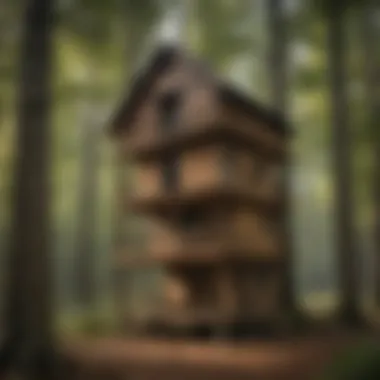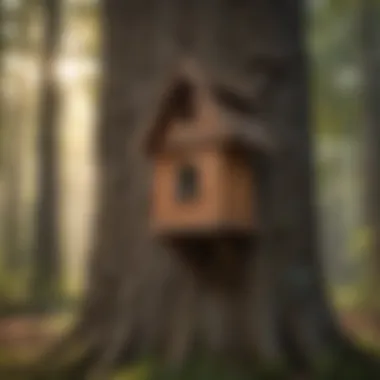Best Locations for Effective Bat House Installation


Intro
Finding the right spot to mount a bat house is not merely a matter of picking a random tree or wall. It requires understanding several ecological factors that support bat populations. Bats play a crucial role in our ecosystems, offering natural pest control and aiding in pollination. Therefore, choosing an optimal location for a bat house is essential not just for the bats themselves but for the broader environment. By taking into account the environmental conditions, structure, and social dynamics, we can enhance the likelihood of bat occupancy.
Before diving deeper into specific guidelines and factors, it's vital to acknowledge the pressing challenges posed by urbanization and habitat fragmentation. These elements often threaten local wildlife, making strategic placement all the more critical.
Forestry Elements
When it comes to selecting locations for mounting bat houses, several paramount aspects come into play:
- Sunlight: Bats thrive in environments where their roosting areas receive ample sunlight. Ideally, your bat house should get at least six hours of direct sunlight each day. This warmth helps with temperature regulation, particularly essential for nursery colonies.
- Height: Typically, mounting a bat house at least 10 to 15 feet above the ground is advisable, promoting safety from predators and allowing easy access to surrounding foraging areas.
- Proximity to Water: Ensuring the placement of bat houses near natural water sources, such as ponds or streams, can significantly increase the odds of attracting bats. Water sources draw in insects, which in turn attract bats, creating a symbiotic relationship.
With these foundational insights in mind, let's delve into a more detailed exploration of factors—starting with the unique characteristics of evergreen trees as potential bat house structures.
Understanding Bat Biology and Behavior
To effectively mount a bat house, one must first appreciate the distinct biology and behavior of bats. Unlike many creatures, bats are more than mere aerial acrobats; they play a crucial role in maintaining the delicate balance of our ecosystems. Their nightly foraging and roosting habits reveal important insights into their needs and behaviors, which are fundamental when determining optimal placement for bat houses.
The Role of Bats in Ecosystems
Bats serve as natural pest controllers, consuming vast quantities of insects each night. A single bat can eat up to 1,200 mosquitoes in an hour. This is particularly beneficial in agricultural settings, where crops may be threatened by pest populations. Thus, by providing a roosting space, one supports not only bat health but also broader ecological dynamics.
Moreover, some bat species aid in pollination and seed dispersal, facilitating the growth of various plants and trees that are essential for maintaining biodiversity. According to studies, forestry systems that promote bat habitation see a noticeable boost in tree regeneration. In short, their presence can have multiplier effects on local flora and fauna, making bats indispensable allies in conservation efforts.
Natural Roosting Preferences
Understanding how bats prefer to roost informs the design and placement of bat houses. Many bats are cavity-dwelling creatures, favoring secluded spots that provide safety from predators. They often seek out structures like trees, buildings, or rock crevices with specific microclimatic conditions—typically warm, dry environments sheltered from the wind. Moreover, different bat species exhibit varying preferences. For example, pipistrelle bats are more inclined to roost in tree holes while others seek out buildings.
This diversity implies that when deciding where to mount a bat house, one must consider the species present in their area. Recognizing local bat populations and their preferences can lead to ensuring higher occupancy rates.
Social Structure of Bat Colonies
Bats exhibit complex social structures that can influence their roosting behavior. Some species, like the little brown bat, tend to cluster in large colonies with many individuals sharing space. In contrast, others may prefer solitary roosting. Social interactions among bats, such as grooming and vocalizations, are crucial for their reproductive and social stability. In densely populated areas, providing a well-placed bat house can enhance local social structures, allowing colonies to thrive.
For those seeking to attract bats, during the breeding season, houses should ideally be placed near established colonies or natural roosting sites. This not only increases the probability that bats will take up residence but also nurtures local biodiversity by fostering healthier, more resilient bat populations.
It’s essential to remember that understanding bat behavior and ecology isn’t just an academic pursuit; it provides actionable insights into how we can create environments that support these vital creatures.
Factors to Consider When Mounting a Bat House
When it comes to ensuring that bat houses serve their intended purpose, several factors come into play. Understanding these elements can significantly boost the chances of attracting bats to roost in your structure. Not only does this benefit the bats themselves, but it also contributes to the local ecosystem by enhancing biodiversity and aiding in insect control through natural predation.
Height of Mounting
The elevation at which you install a bat house is paramount. Generally, bats prefer their homes elevated since this helps them stay safe from ground-based predators. A mounting height between 10 to 15 feet is often recommended, but the higher, the better. However, don't go overboard; a spot that's too high might complicate access for maintenance. You might think that drones could help with those high places, but the real nature's aviators—bats—are probably more effective at doing their own aerial inspections!
Additionally, the height benefits bats by allowing free flight paths. If your bat house is buried deep in foliage or obstructed by branches, bats may find it tricky to navigate, limiting their willingness to take up residence.
Weather and Climate Influences
One cannot underestimate the effect of the local climate on bat habitation. Bats are generally creatures of comfort, preferring environments that align with their activity patterns. For instance, areas that experience extremely harsh winters may not be ideal for housing bats; less lucid species might seek out more temperate microclimates.
It's crucial to consider how various weather conditions impact the placement of your bat house. Take note of sunny spots during the day, as bats tend to favor warm roosts that can reach temperatures between 80 and 100 degrees Fahrenheit. That's sweet bat real estate! On the flip side, ensure that spots don't get too hot. A balance is key—think of it like finding a comfortable chair at your favorite café, not too stuffy, but warm enough to enjoy a hot cup of coffee.
Distance from Natural Features
When mounting a bat house, proximity to natural features is also something that deserves attention. Bat species are often attracted to water bodies and nearby trees, which provide both feeding opportunities and safety from predators. Ideally, a distance ranging from 2 to 20 feet from a natural water source can enhance bat activity, while still keeping the houses safe from any disturbance.
Moreover, incorporating various plant species around the area can enhance the habitat's attractiveness, enriching the feeding landscape for bats. It’s like setting up a buffet just for them—lots of tasty options to keep them coming back for more! But remember, placing your bat house still needs to be in a somewhat open area to give bats easy access to their foraging grounds.
To maximize bat occupancy, take time to evaluate your specific environmental conditions and the needs of the local bat species before you decide on a mounting location.
Taking into consideration these factors can substantially improve the effectiveness of your bat house, creating a win-win for both bats and the ecosystem. Choose wisely!


Ideal Locations for Bat Houses
Finding the right location for mounting a bat house is not just a matter of convenience; it plays a critical role in attracting these beneficial creatures to your yard. Bats are natural pest controllers, helping to keep insect populations in check. When strategically placed, bat houses can effectively provide refuge for these animals, significantly boosting their chances of occupancy and enhancing local biodiversity. Selecting optimal locations takes into account various elements such as environmental attributes, safety from predators, and proximity to natural resources, all of which can impact bat behavior and survival.
From understanding the need for water sources to establishing height and safety against predators, each factor contributes to the decision-making process in bat house placement. It is essential that all these considerations are harmoniously integrated to ensure bats find a welcoming haven.
Near Water Sources
Bats, like many other wildlife species, are drawn to water. Placing bat houses near water sources such as ponds, lakes, or rivers can be a game changer in attracting them. Water bodies provide bats not only with drinking opportunities but also with a rich hunting ground as they flutter through the air to capture nocturnal insects hovering above the water's surface. In densely populated areas, nearby water can become a sanctuary for bats that might otherwise be deterred by urban encroachment.
When you're choosing a site, look for locations that are within 10 to 30 feet from the water. This distance is generally ideal, as it puts the bats close enough to easily forage while providing them with a safe flight path. If possible, ensure the area around the water is somewhat free from disturbances such as heavy foot traffic or frequent noise, which could scare them away.
In Tree-Hung Structures
Mounting bat houses in trees can be particularly beneficial; trees provide a natural canopy that enhances the sense of security for bats. Trees can act as both a shelter and a waypoint for bats coming in to roost. Ideally, you should look for trees that have a mix of sunlight and shade, as this can create a more inviting microclimate for bats. Positions that allow the house to be hung at least 15 feet off the ground are preferable, as this height minimizes disturbances from ground predators, including house cats.
Furthermore, utilizing natural tree formations also allows the bat house to blend seamlessly into the environment, which can help in reducing human interference. Additionally, providing multiple houses on different trees can attract a larger number of bats as individuals tend to prefer roosting near others of their kind.
Above Ground Level and Away from Predators
The safety of bats is paramount when determining where to mount a bat house. Elevating bat houses high above ground level is crucial. Heights of at least 10 to 15 feet are recommended to deter predation by raccoons, hawks, or other predators. Some species of bats are particularly vulnerable and can be easily threatened during their vulnerable roosting periods.
It's important to place the bat house away from clutter, which can provide cover for predators looking to ambush bats coming and going. An open area that allows for clear flight paths serves both as a help in their navigation and a deterrent against ambush predators.
When considering placement, take into account potential climbing routes for predators. For example, if there are nearby trees or structures that these animals could climb, it might be wise to create a buffer zone. Sometimes adding barriers can also help in keeping predators at bay.
Optimal placement can significantly enhance the occupancy of bat houses, fostering more robust bat populations that benefit the ecosystem.
In essence, securing points that marry safety, accessibility to water, and natural roosting structures greatly improve the likelihood of attracting bats. A careful selection based on these criteria not only supports the local fauna but ultimately contributes to maintaining ecological balance.
Avoiding Common Mistakes
When it comes to mounting a bat house, understanding some common pitfalls is crucial. Many well-meaning individuals who wish to support bat populations inadvertently make choices that can limit occupancy or even deter bats from using their homes. By focusing on these missteps, enthusiasts can ensure a productive and beneficial environment for these creatures, as well as enhance their own experience of observing wildlife.
Mounting Too Close to Human Activity
One of the biggest blunders in bat house placement is positioning it too near areas with frequent human interaction. Bats, being naturally skittish creatures, prefer locations that allow them to feel safe and undisturbed. Proximity to busy roads, playgrounds, or heavily trafficked outdoor spaces could lead bats to avoid the area altogether.
To optimize bat house usage, try to mount the structures at a distance where human activity is limited. Consider urban and suburban settings where backyards are plentiful; placing bat houses at the edge of property lines or away from windows may help. The key is to strike a balance between accessibility for humans and seclusion for bats.
Bats are quite shy and are likely to seek shelter elsewhere if disturbed too frequently.
Selecting Inappropriate Locations
Selecting the right spot for the bat house is an art. Placing it in unsuitable areas—such as dark, damp locations or very exposed spots—can greatly affect bat occupancy. Bats are attracted to environments that mirror their natural habitats; thus, a house located deep in the woods or near a windy area may not be inviting.
When considering locations, take note of factors such as:
- Sunlight Exposure: A few hours of sunlight is ideal for warming the bat house. Too shaded can deter use.
- Microclimate: Small variations in temperature and humidity can make a significant difference.
- Nearby Food Sources: Proximity to gardens or wetlands where insects thrive can significantly appeal to bats.
Thoughtful selection of these aspects ensures that your bat house is as welcoming as it can be.
Using the Wrong Materials for Construction
When building or installing a bat house, the materials utilized are integral to its long-term success. Many people might think that durability is the only concern, but using the wrong types of materials can deter bats. For instance, freshly treated wood may emit harmful fumes that can be toxic to bats.
Ideally, construction should rely on:
- Untreated, naturally durable woods: Cedar and plywood are often good choices that stand against weathering without harmful chemicals.
- Proper insulation and ventilation: Avoiding materials that retain moisture can help in maintaining an appropriate climate inside the house.
Ensuring that your bat house is constructed from the right materials contributes not just to their comfort, but to their overall health as well.
Maintenance and Monitoring of Bat Houses
Effective maintenance and monitoring of bat houses are critical to their success as roosting sites. As bat populations face numerous pressures, including habitat loss and pollution, ensuring these structures remain suitable for occupancy is paramount. Regular care not only enhances the longevity of the bat house but also fosters a healthy environment that can support local bat populations.


Regular Inspection Protocols
Establishing a routine check-up schedule for bat houses can make all the difference in their functionality. Inspections should typically occur before and after the peak bat season, which usually spans from spring to early fall. During these inspections, several key elements must be assessed:
- Structural Integrity: Look for any signs of damage, such as holes or cracks, that could compromise the space.
- Pest Intrusion: Any signs of wasps or other undesirable pests should prompt immediate action.
- Wear and Tear: Keep tabs on paint, wood deterioration, and any weather-related impacts.
Observing these factors helps to determine whether repairs are needed. It’s essential to take note of any trends, such as increased damage in specific areas, which could signal further issues that need addressing.
Assessing Bat Activity
Understanding bat activity is crucial for gauging the success of a bat house. Observation should be done during twilight hours when bats are most active. Here are some steps to effectively assess activity:
- Silent Observation: Sit back and watch without disturbing the bats. This will allow you to count the number of bats emerging.
- Listen for Sounds: Cubes of chirps or squeaks can indicate the presence of bats and their health.
- Guano Collection: Look for droppings beneath the bat house, which can signal activity and offer insights into diet and health.
Analyzing these aspects will provide a clearer picture of the bat house's effectiveness and any potential adjustments needed for the structure. By keeping tabs on the engagement of local bats, one can enhance the overall experience for both the bats and the nature enthusiast.
Cleaning and Repairs
Cleaning and repairs aren't just chores; they're essential to maintaining the habitat’s usability. It’s recommended to perform cleaning shortly after bats have vacated the house, typically in late fall or early winter. Here’s how to go about it:
- Remove Debris: Clear away any leaves, twigs, or other clutter that has accumulated in or around the house.
- Disinfect the Interiors: Use a mild solution of water and soap to wipe down surfaces and remove guano.
- Address Repairs: Fix any structural damages noticed during inspections. Depending on what materials were used in construction, this can involve patching holes with natural wood glue or replacing damaged panels entirely.
Adhering to these cleaning protocols safeguards the bat house against diseases and creates a comfortable environment for future occupants. It’s no different than maintaining a home for other wildlife; keeping it tidy and secure paves the way for successful roosting.
"Proper maintenance practices for bat houses not only enhance their durability but also make a notable difference in the health of bat populations in urban and rural landscapes."
In summary, regular maintenance and careful monitoring of bat houses are vital components in ensuring these critical habitats thrive. By dedicating time to inspections, understanding bat activity, and performing necessary cleaning and repairs, one can enhance the success rate of these structures while contributing to the overall conservation efforts of these essential flying mammals.
Legal and Ethical Considerations
Understanding the legal and ethical landscape surrounding bat conservation is vital for anyone contemplating mounting a bat house. These elements intertwine with the responsibility of fostering habitats that benefit both bats and ecosystems while adhering to regional regulations. Each aspect contributes not only to the welfare of the bats but also promotes an attitude of stewardship toward wildlife.
Regulations on Wildlife Preservation
Different regions may impose distinct regulations that protect bat species and their habitats. Governments often implement laws under wildlife protection acts to safeguard these creatures from hunting, habitat destruction, and disturbances during roosting periods. When planning to mount a bat house, it’s crucial to familiarize oneself with these regulations.
- Permits and Compliance: Some areas require permits for bat house installation, especially in protected habitats. Always check local wildlife agencies or conservation organizations for guidance.
- Seasonal Guidelines: Regulations might restrict when it's appropriate to construct or place bat houses to avoid disrupting breeding cycles or causing stress to existing colonies.
- Protection of Endangered Species: Certain bat species are listed as endangered or threatened. Knowing this can greatly influence where and how bat houses can be positioned.
Taking steps toward compliance not only nurtures local bat populations but also encourages sustainable practices within your community. Being proactive about regulations ensures you are on the right side of the law.
Ethical Interaction with Bats
The ethical dimension of interacting with bats encompasses respecting their natural behaviors and habitats. Building a bat house isn't simply about providing shelter; it’s about creating a harmonious coexistence.
- Habitat Respect: Avoid placing bat houses in areas that would drastically alter or harm the local fauna. Bats thrive in environments that closely mirror their natural habitats. Disturbances can lead to increased stress and force the bats to relocate.
- Avoid Disturbance: Bats are sensitive to disturbances, particularly during roosting. Minimizing human noise and activity nearby is critical, particularly when bats are active. Therefore, choosing a serene location is essential.
- Observation Over Interference: Observe bats from a distance without encroaching on their space. Using a light source or a camera trap can allow you to monitor activity without intruding.
Engaging with bats ethically allows for a more sustainable relationship and supports ecological balance.
By understanding both the legal requirements and the ethical imperatives of bat conservation, individuals can contribute to nurturing healthy ecosystems while also promoting awareness and education among their communities. This synergy between legal compliance and ethical placement enhances both bat welfare and biodiversity in the environment.
Adapting to Urban Landscapes
As urban areas expand, adapting our understanding of bat habitats and behavior becomes crucial. Traditional bat roosting environments like forests and caves are increasingly marginalized by sprawl and development. This reality beckons a rethinking of bat conservation strategies, emphasizing the importance of not just preserving existing habitats but also creating new opportunities for bats to thrive in urban landscapes.
Incorporating Green Spaces
One of the most effective ways to adapt to urban landscapes is through the strategic inclusion of green spaces. Parks, gardens, and green roofs serve not just as recreational spots, but as vital refuges for bats and other wildlife. Even small plots, such as residential gardens, can play a role in providing essential resources.
- Benefits of Green Spaces:
- Habitat Creation: Green spaces allow for the fostering of insects, which are the primary food source for bats.
- Corridors for Movement: They can function as pathways that connect fragmented habitats, allowing bats to navigate through urban areas safely.
- Cooling Effects: Trees and plants help moderate temperatures, providing cooler roosting conditions that bats prefer.
Incorporating native plants—those that are indigenous to the area—can yield even better results. Native flora tends to host the local insect populations that bats feed on, making these green spaces more inviting. Furthermore, public gardens or areas near water bodies that include suitable plants can significantly impact attracting bats.
Creating Bat-Friendly Structures


Another fundamental aspect of urban adaptation is the construction of bat-friendly structures. Buildings don’t have to be bat barriers; with some foresight, they can become havens for these creatures. Here are a few design considerations:
- Strategic Mounting: Bat houses should be mounted at least 10 feet off the ground, ideally on the south or southeast side of a building, ensuring they receive ample sun exposure.
- Use of Materials: Materials that mimic natural roosting sites, like untreated wood for bat houses, resonate with bat's preferences for safety and warmth.
- Integration with Architecture: Structures like bridges and eaves can be adapted into roosting sites. Considerations like openings or gaps in gables or wall crevices can provide convenient roosts for bats.
Designing these structures should involve local ecological knowledge to ensure that they align with bat preferences as well as existing municipal guidelines. It’s beneficial to encourage community members to partake in this endeavor, creating a collective consciousness about bats and their role in the ecosystem.
"Creating bat-friendly spaces in cities is not just about conservation; it’s about integrating wildlife into the urban framework to promote biodiversity".
The key takeaway here is that by accommodating bats in our urban planning efforts, not only do we contribute to their preservation, but we also foster a broader ecological balance that benefits all urban wildlife. Through thoughtful development and innovation, we can cultivate urban environments where both humans and bats can coexist harmoniously.
Enhancing Local Biodiversity
Encouraging bats to inhabit an area is a crucial aspect of promoting local biodiversity. Bats serve many essential roles in our ecosystems, acting as natural pest controllers, pollinators, and seed dispersers.
By strategically mounting bat houses, we can help bolster bat populations, which in turn can enhance the overall health of our ecological surroundings. When bat houses are incorporated into local environments, they provide not only a roosting site but also create a network that encourages other wildlife to flourish.
Encouraging Co-Habitation with Other Species
When bats settle in an area, they often do so in conjunction with various other wildlife. By facilitating the right conditions for bats, we may also be nudging the ecosystem toward fostering species that coexist peacefully.
- Creating a Diverse Habitat: Increasing plant variety through native flora attracts all sorts of critters, making it a win-win scenario. The more plants you have, the more insects and small mammals will be drawn. This encourages a richer tapestry of life, with bats as essential players in the food web.
- Natural Pest Control: With the increasing menace of agricultural pests, having bats around can significantly lessen the chemical dependence of local farmers. They can consume thousands of insects a night, including mosquitoes that can carry diseases. By encouraging bat populations, it's not only beneficial for the crops but also helps keep pest populations in check.
"Each bat can eat up to 1,200 mosquito-sized insects in just one hour. Imagine the kind of bug control that can happen with a thriving bat community."
Impact on Insect Population Control
Bats are like little flying vacuum cleaners when it comes to insect control. The impact these creatures have on insect populations is staggering. With a single bat capable of consuming a multitude of insects in one night, their presence can lead to a noticeable decline in insect numbers, provided the right conditions are met.
- Diversity of Diet: Different bat species consume different types of insects. Having various bat species in an area can ensure comprehensive pest management, targeting everything from beetles to moths, allowing for a balanced ecosystem.
- Economic Benefits: Reduced pest populations can lead to less reliance on pesticides, which can benefit both the environment and local agricultural economies. Many studies suggest that bats save the agricultural industry millions of dollars through their natural pest control.
Encouraging the habitation of bats through well-placed bat houses offers various benefits that extend beyond the immediate area, ultimately contributing to a richer and healthier ecosystem.
Community Engagement and Education
The placement and maintenance of bat houses cannot be left solely to individual enthusiasts. The widespread awareness and support of the community play a crucial role in maximizing the effectiveness of these structures. Engaging the community fosters a deeper understanding of the importance of bats in local ecosystems. Bats provide natural pest control, pollination, and seed dispersal, enhancing biodiversity which benefits local agriculture and ecosystems. By promoting community initiatives, we can encourage residents to adopt a more eco-friendly approach to their surroundings.
Involving the public also brings together diverse expertise and resources, helping to create a more cohesive strategy for bat conservation. The success of bat houses relies heavily on their locations, so a well-informed community can make a significant impact on their occupancy rates.
Initiatives for Public Awareness
To raise awareness, various initiatives can be implemented. Social media platforms, such as Facebook and Reddit, serve as valuable tools for sharing information about bats and their habitats.
- Create informative posts: Highlight the ecological importance of bats in controlling insect populations and discuss the types of bat houses suitable for different environments.
- Organize community events: Hosting bat nights or bat walks can captivate the public's interest. This allows people to observe bats in their natural habitat, enhancing their appreciation for these flying mammals.
- School programs: Collaborating with local schools to educate students about bat biology can nurture a sense of responsibility toward wildlife conservation from a young age.
Such initiatives create a ripple effect. When the community is informed about the benefits of bats, people are more likely to support bat-friendly practices such as planting native flora and reducing pesticide usage.
Workshops and Educational Programs
Workshops and educational programs are essential in equipping community members with the knowledge and skills necessary to effectively manage bat houses. These learning opportunities can cover various topics relevant to bat conservation.
- Building bat houses: Teaching participants how to construct bat houses fosters a sense of involvement. Building these structures with proper materials ensures their durability and suitability for different bat species.
- Monitoring bat populations: Practical sessions on how to monitor bat activity can encourage citizens to engage actively with their local wildlife. They can learn methods to detect bat presence, such as using acoustic monitors to capture echolocation sounds.
- Support local bat research: Involving community members in ongoing research projects can foster an appreciation for scientific endeavors and their significance to bat conservation.
As local people become educators themselves, the impact widens. Transforming residents into advocates can help nurture a culture of environmental stewardship that benefits not only bats but the entire ecosystem.
One of the benefits of engaging communities through workshops is the shared responsibility. When individuals take ownership of their local bat houses, they are more inclined to monitor their condition and promote their effectiveness. Whether it’s a backyard initiative or a larger community project, such collaborations between residents and organizations pave the way for sustainable conservation efforts.
Culmination
The placement of bat houses is crucial in supporting not just the local bat populations but also the larger ecosystem. This article emphasizes how understanding where to mount these structures can significantly enhance their occupancy rates. By taking into account environmental factors, social behavior, and urban challenges, we can position bat houses in a way that offers bats essential roosting sites.
Summary of Best Practices
- Mounting Height: Research suggests placing bat houses at least 12 to 15 feet above ground to deter predators and provide a safe space for bats.
- Proximity to Water: Locate bat houses near water bodies, as bats are drawn to these areas for insect availability.
- Atrategic Sun Exposure: Ensure that the houses get morning sunlight for warmth, but avoid direct afternoon sunlight that may overheat them.
- Avoiding Human Activity: Keep bat houses at a distance from high traffic human zones to reduce disturbances to bats. This might include being mindful of locations close to parks or buildings where there is significant human interaction.
Future Considerations for Bat Conservation
As we look ahead, the importance of bat conservation remains vital. Urbanization continues to challenge habitats, aiming to integrate natural spaces within city layouts is essential.
- Creating Habitat Corridors: Develop urban green spaces that allow bats to travel safely between roosting sites and feeding grounds.
- Education and Awareness: Promoting understanding and appreciation of bats among local communities can foster support for conservation initiatives.
- Legislation Support: Encouraging policies that protect natural habitats will ensure sustainability for bat populations moving forward.
In sum, thoughtful location choices for bat houses are not merely practical; they hold the potential to enhance biodiversity, control insect populations, and engage communities in conservation. By working towards sound bat conservation practices, we lay the groundwork for a balanced ecosystem where both human and bat needs can harmoniously thrive.



